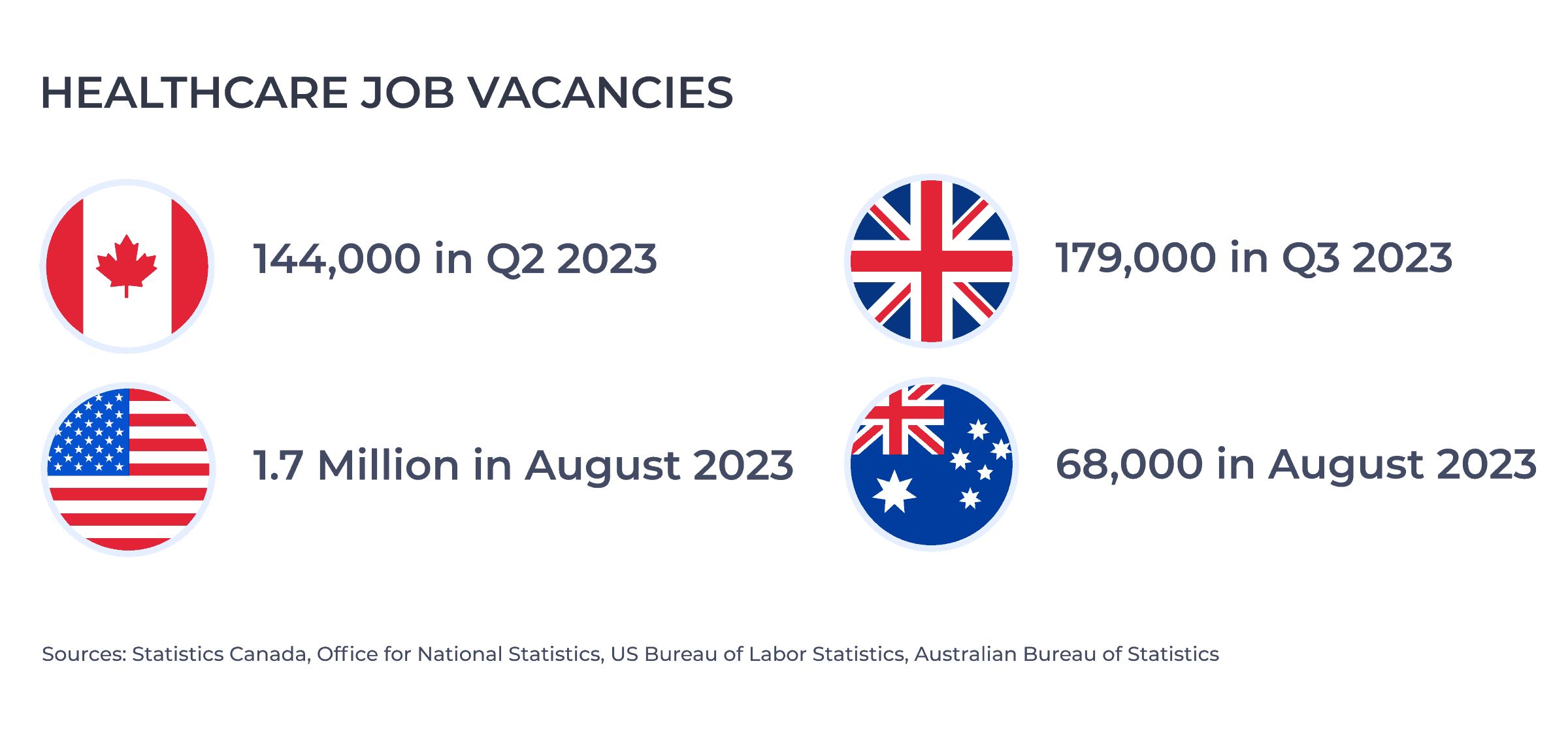Every year, we learn more about the needs and priorities of international students. We learn more about what motivates their decisions, about the policies that impact their mobility, and about what to do with this information.
Building off our 2024 Trends Report, we’re leveraging the latest information—including our internal data and surveying tools—to predict what 2024 has in store for international education. With Canada, Australia, and the UK all announcing major policy shifts and global competition for international students at an all-time high, 2024 promises to be a year of change in the sector.
Here are our top five predictions for what will unfold in international education this year.
1. The UK Dependants Policy Will Lead to Increased Indian and Nigerian Enrollment in Major Destination Markets
The UK’s decision to prevent most postgraduate students from bringing dependents with them is a massive shift that promises to impact every major destination market.
Nigeria and India accounted for 73% of incoming dependents of international students to the UK from Q1 to Q3 2023. Following the policy announcement, we predicted a drop in incoming students from those countries. Recently released UK Government data for Q3 confirmed these projections, showing a 13% decline in study visas granted to Indians and a 26% decline in study visas granted to Nigerians compared to Q3 2022.1
If the trend we saw in Q3 2023 were to hold throughout 2024, the UK would welcome 32,000 fewer Indian and Nigerian students this year than in 2023. But it’s worth noting that the Q3 dip was purely a reaction to the announcement made last May. The actual legislation didn’t take effect until January 1, 2024, meaning this decline may foreshadow a much more significant drop.
Tens of thousands of Indian and Nigerian students may thus be looking for a destination other than the UK this year. Here’s how Canada, the US, and Australia are positioned to benefit from this demand.
Potential Impact on Canada, the US, and Australia
While Canada has seen large Indian and Nigerian student inflows over the past few years. And while Nigerian demand for a Canadian education is at an all-time high, Indian demand fell significantly during the latter half of 2023, potentially due to a growing negative sentiment towards Canada in Indian media. Canada also raised the minimum proof of funds requirement to obtain a study permit in November. While this is a positive move for students’ well-being in Canada, it may also potentially price out some Indian and Nigerian students.
The number of new Indian students in the US grew by 11% in 2023,2 and is primed to grow by an even larger amount in 2024.3 But with a presidential election looming, a potential second Trump presidency may dissuade students from pursuing their studies in the US, as we discuss further below.
Australia may be in the most advantageous position of this group. The Australian government has embarked upon significant migration reform, which includes reductions in the number of years students can work after graduation. However, Indian students are exempt from these changes. With this in mind, we think Australia in particular is well positioned for an influx of Indian students.
2. Anglophone Destinations Will Lose Market Share to Non-Anglophone Destinations
With students more concerned about affordability than ever before, we predict they will increasingly look at options beyond the big four to plot out a study abroad journey that fits their budget. Here are some of the top non-anglophone markets that we see competing for international students this year.

Germany hosted a record number of international students last year, with around 368,000 foreign nationals enrolled in higher education institutions during the 2022/23 academic year.4 That was a 5% increase from the previous year.
Germany offers free tuition for nearly all study programs at public universities. Work opportunities and immigration pathways available to students in Germany are two other factors driving growth. Following graduation, students can apply for an extended 18-month job-seeking visa to find work related to their area of study.5
Nearly 40% of all international students in Germany end up immigrating there—the highest stay rate in the world behind Canada.6 And in December 2023, Germany launched a pair of new initiatives designed to boost the retention of foreign graduates of German universities and to attract foreign degree holders to live and work in Germany.

During the summer of 2023, the South Korean Ministry of Education announced its South Korea 300K Project, a collaborative strategy between institutions, local businesses, and government to attract 300,000 international students by 2027.
This project aims to reduce language barriers by introducing more lenient testing measures and streamline permanent residency applications, allowing eligible students to obtain PR after three years instead of six.

Taiwan is planning to recruit over 320,000 students by 2030 and increase its post-graduation retention rate from 40% to 70%. The Taiwanese Ministry of Education will also facilitate the establishment of special fast-track courses, especially in STEM fields, encompassing double bachelor programs, two-year bachelor degrees, and two-year master’s and doctoral programs.
The Bottom Line
In 2024, international students will have more options than ever before. To stay competitive, institutions must prioritize innovation and student-centric approaches. A key strategy involves clearly communicating postgraduate opportunities.
Spanish-speaking students are favouring Chile, Mexico, and Spain at higher rates than ever before. At the same time, East Asian students are diverting their attention to East Asian destinations, potentially at the expense of anglophone options. It remains to be seen where student inflows will net out, but we can say two things for certain. Competition for international students is at an all-time high, and cost efficiencies matter to those students.
3. Software Engineering Will Become Even More Popular
In 2023, technology, software engineering, computer programming and IT was not only the most-searched subcategory in engineering and technology, but also the most popular subcategory on the entire ApplyBoard platform.7
12% of all searches on the ApplyBoard platform in 2023 were for technology, software engineering, computer programming and IT. This subcategory also accounted for nearly half of all searches in the engineering category during the first nine months of 2023.
Based on ApplyBoard’s internal projections, technology, software engineering, computer programming and IT will become even more popular in 2024. Our internal projections also suggest computer science will experience a surge in popularity, such that it could rival technology, software engineering, computer programming and IT for the title of most popular subject by the end of this year.
With interest in these program types building, institutions must do everything they can to educate prospective students on the growing need for STEM jobs and the different career paths they could pursue. A recent study by IBM revealed that 40% of students felt the biggest barrier to pursuing STEM development was not knowing where to start. The more institutions do to address this disconnect, the more they can capitalize on this wave of interest.
4. Students’ Study Interests Will Align More Closely with Job Market Needs
ApplyBoard’s Student Pulse Survey confirmed that budget and affordability are primary concerns for international students right now. As students feel financial pressures, they are likely to pursue careers which offer them a more secure pathway to prosperity.
One area of study experiencing sizeable job vacancies right now is healthcare. It’s well documented that Australia, Canada, the UK, and the US all have aging populations and low birth rates, causing a growing need for healthcare workers. Here’s a brief overview of the labour needs across all four destinations:

At ApplyBoard, we’ve seen student interest in health-related fields creep up recently. “Health” was one of the top three search terms on our platform in 2023 and has seen growth in each of the past three years. But 2024 may be the year we see this field of study surge in popularity.
We ran our Student Pulse Survey twice in 2023, in April and October. In just five months, we saw a substantial shift in student interest:
In April, 14% of students expressed interest in health-related studies. Fast forward five months and things have changed—23% now express a keen interest in the field of health. Meanwhile, the longtime-reigning champion, business, saw a dip in popularity. The fall survey revealed a decline from 47% to 36% in students eyeing business in 2023.
While it’s not definitive, we think this shift reflects students becoming more attuned to what jobs are in demand. Look for applications for health programs to continue rising in 2024 as students continue to recalibrate their academic compasses to align with opportunities in the job market.
5. Government Policy and Upcoming Elections Will Have a Substantial Impact on Student Mobility
Elections, from campaign rhetoric through their outcomes and the policy changes that follow, can have a profound impact on how international students perceive potential study abroad destinations. Here’s how we see upcoming races and policy changes affecting the sector in 2024.
Canada is not scheduled to elect its next federal government until October 2025. And with current projections showing the governing Liberal party well down in the polls, It’s unlikely that an election will be triggered before that time. But, perhaps with the next election in mind, the Canadian government has made significant policy announcements over the past few months aimed at safeguarding international students improving their experience in Canada.
The country recently announced a trusted institutions framework for Fall 2024, which will allows institutions which meet certain criteria to receive priority for study permit processing. And as of December 2023, institutions must confirm their letters of acceptance directly with IRCC.
While these are positive shifts, we may see study permit processing delays with the new processes. ApplyBoard’s internal data showing significant declines in tuition deposit rates the longer an applicant waits to receive their letter of acceptance. This could lead to other destinations becoming more attractive to some students, at least in the short term.

Americans head to the ballot box on November 5 to elect their next president, and as things stand, it looks likely that the US is headed toward a rematch between President Joe Biden and former President Donald Trump.
Student visa applications in the United States fell every year from 2015 up until post-pandemic recovery started in 2020. Many experts attributed part of this fall to the Trump Administration’s rhetoric and policies, which raised some concerns for certain students.
We’ve seen a swift recovery from the US sector over the past couple of years, but if we see similar messaging to what we experienced during Trump’s first campaign in 2016, the 2024 election cycle could undo the application rebound of 2022 and even suppress incoming student inflows for the next couple of years.

Though the next federal election in Australia is well off, the country is in the midst of implementing key policy changes which will alter the international student experience. Similar to Canada’s, Australia’s new migration policy is focused on reducing application fraud.
Australia’s new migration policy is anchored by the introduction of the Genuine Student Test—a test designed to distinguish genuine applicants from those whose primary intent is work, ensuring a fair and transparent system. It’s the hope of the Australian government that this will encourage sincere applications and discourage misuse.
While this policy change will no doubt frustrate some individuals, it should help ensure that those who do get issued visas will be ones with true academic goals.
Upcoming ApplyInsights Content
In 2024, we’ll be covering all of these trends and more at ApplyInsights. Here are a few of the topics we’re going to explore during the next few weeks:
- IRCC Data Release Breakdown
- Shifts in Field of Study Preferences in Canada
- State of Policy Across Major Destination Markets
- Community Colleges in the US
We’ll also continue to unpack our top insights in bite-sized videos this year, to help you digest the trends of international education.
Subscribe to ApplyBoard’s LinkedIn and YouTube channels for all the latest video content.
Subscribe to ApplyInsights
Sign up for the latest insights on international education.

About the ApplyInsights Team
FOOTNOTES:
1. Main applicants only. All UK data courtesy of the UK Home Office.
2. All US data courtesy of the US Department of State.
3. US data not yet available for 2023.
4. All German data courtesy of the German Academic Exchange Service (DAAD). October 2023.
5. ICEF, International enrolments in German higher education rise again for a new record.
6. OECD, International Migration Outlook 2023.



